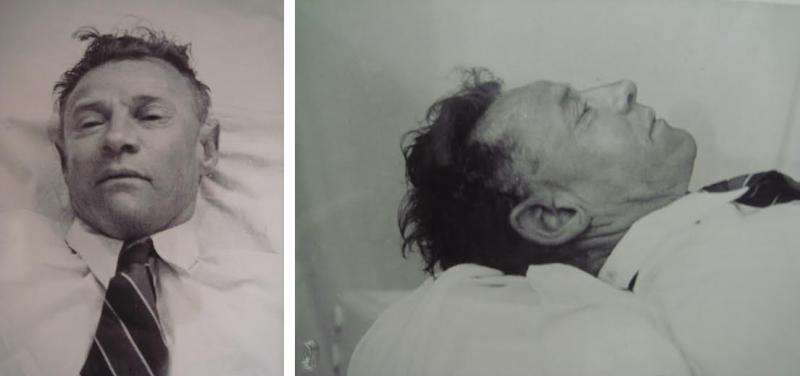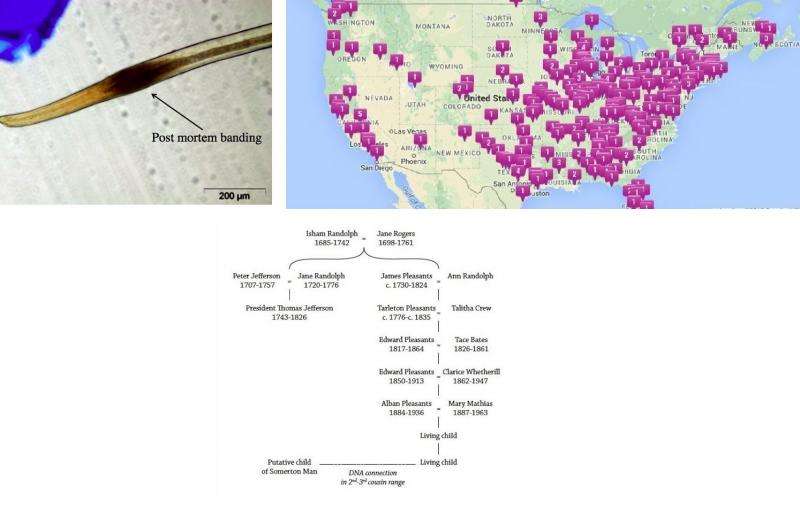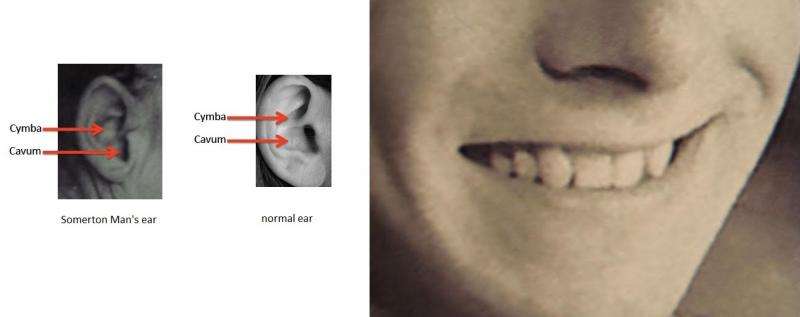June 3, 2015 report
After years of forensic investigation, Somerton Man's identity remains a mystery (Part 2: DNA, isotopes, and autopsy)

(Phys.org)—This is the second part of a two-part story about the forensic investigation of the Somerton Man. Read "Part 1: History and Code" here.
DNA testing
If the cryptographic analysis reaches a dead end, the question of the Somerton Man's identity can also be approached by testing his DNA and comparing it to that of millions of other individuals on genealogical databases.
For now, Abbott and other investigators have access only to DNA from the man's hair samples, which are preserved in a museum. Although the teeth would provide the best source of DNA, so far it has not been possible to exhume the body, since this involves fulfilling various legal requirements from the Attorney General of South Australia.
As Abbott explained, three types of DNA can be tested: mtDNA (inherited maternally), YDNA (inherited paternally), and autosomal DNA (inherited from both sides).
"Autosomal DNA is what's needed, and that's how adopted kids can find their biological parents, by a blind search," Abbott said. "It is inherited from both sides of the family, and when you put it in a genealogical database, you can get matches with recent relatives going up to about fifth cousin. By finding your web of cousins, you can triangulate their family trees and work out your unknown parents."
But the catch with autosomal DNA is that the concentration levels per human cell are much lower than the levels of mtDNA and YDNA. When dealing with human hair that is more than 60 years old, sufficient DNA extraction is a very difficult problem.
In the meantime, the University of Adelaide researchers have run one simple mtDNA test as a first step. The group of Associate Professor Jeremy Austin, at the university's Australian Centre for Ancient DNA (ACAD), found that the Somerton Man's mother belongs to the DNA haplogroup H. About 40% of Europeans belong to this group, so it's not particularly surprising, given the Somerton Man clearly appears Caucasian.
More importantly, however, this successful DNA test shows that viable DNA is still present that has not been contaminated by the formaldehyde embalming fluid. This evidence is one of the requirements needed for petitioning for an exhumation.
Although they are still hoping to exhume the body, for now the researchers are continuing to analyze DNA from the man's hair samples as well as DNA from his putative descendant. Back in 1949, investigators tracked down the owner of a phone number written in the back of the Somerton Man's copy of The Rubáiyát of Omar Khayyám, which brought them to a woman that investigators dubbed "Jestyn," who lived just a block from where the Somerton Man was found. In 1947, while unmarried, she had given birth to a son named Robin. Conversations with relatives, along with compelling anatomical similarities as described more below, suggest that Robin's father may have been the Somerton Man.

Although Robin passed away of prostate cancer in 2009 and was cremated, the University of Adelaide researchers have found a way around this obstacle with modern forensics techniques. The researchers explain that, by essentially subtracting the DNA data of Robin's spouse from the DNA data of his living descendant, they can reconstruct Robin's autosomal DNA profile, producing what is called "phased" DNA data.
The results suggest that Robin had ancestral ties to the US along his paternal line. Several of Robin's distant cousins currently live in the US, with the closest matches having roots in the Virginia area. The results show that Robin even had a cousin who is a direct descendent of Isham Randolph, who was Thomas Jefferson's grandfather. Moreover, using data from the Eurogenes K13 Project, the researchers found that Robin inherited DNA from his father that contains a small fraction of American Indian DNA. Taken together with the fact that the Somerton Man was wearing a jacket and tie of US origin, the evidence makes a compelling case that the Somerton Man was an American.
"This is not conclusive and the mystery is by no means solved," Abbott said. "But physical evidence such as this points us to where it might be profitable to concentrate our future efforts."
Isotope testing
The 60-year-old strands of hair may hold other secrets besides those contained in the DNA—specifically, information about the isotopes of the elements in his system, which may provide clues about the Somerton Man's lifestyle.
Uncovering the isotope information involves first burning a 1-cm length of hair with an excimer laser beam and then analyzing the isotopes in the burned hair using a technique called laser ablation Inductively Coupled Plasma Mass Spectrometry (ICP-MS), which was carried out by Dr. James Chappell at the University of Adelaide. Preliminary results show that the Somerton Man had higher-than-normal levels of arsenic, lead, and strontium-88 in his system. The high arsenic level is not surprising since environmental arsenic levels in industrialized societies were higher in the 1940s than they are today. Although the man's lead content was enormous about a month before his death, it decayed as time went on, so it does not appear that lead was what killed him. As Abbott explained, the strontium-88 level is perhaps the most intriguing.
"The strontium-88 is very interesting, as there is a very sharp change about one-and-a-half weeks before death," he said. "This would indicate that there's been a change in the environment. Is this when he travelled, so he drank different water and ate vegetables from a different region? This gives us clues as to the timeline of his possible movements. One hypothesis is that he came from Sydney and looked for Jestyn in Melbourne, before traveling to Adelaide. Perhaps the strontium evidence indicates that he spent over a week in Melbourne. This is something investigators can bear in mind when analyzing the man's timeline and possible movements."
Photographic and dental forensics
Although not as high-tech as the previous methods, a close analysis of the post-autopsy photographs and dental records reveals a surprising amount of information—from a mole near his lip to pronounced nasal arches—that may contribute to uncovering the Somerton Man's identity.

In general, as Abbott explained, autopsy photos bear little resemblance to the living individual, since the facial muscles and skin tend to sink post mortem, often drastically changing the person's overall appearance. In addition, it's clear from the photos that the Somerton Man had an autopsy because of the ridge on his forehead, which is where his skull cap was sawn off. However, certain features, such as the ears, can offer useful markers.
It turns out that the Somerton Man had unusual ears in that his upper ear hollow (the cymba) was much larger than his lower ear hollow (the cavum). This feature occurs in only 1% of the population. It may not be a coincidence, then, that photographs of his putative son Robin show that Robin also had a very large cymba.
Another revealing feature of the Somerton Man's ears is that he had a small crease on his earlobe, technically called a diagonal earlobe crease (DELC). Oddly enough, research has shown that DELCs are correlated with an increased risk of ischemic heart attack. While the autopsy found he had a good heart at the time of death, had he lived longer he may have developed coronary problems. This is another bit of information that could prove useful in the future, suggesting that investigators might check for heart disease in his relatives, should candidates one day be found.
The Somerton Man also had a relatively rare dental condition: he was missing both lateral incisors, resulting in his canine teeth being directly next to his top central teeth. At the 1948 inquest, the pathologist who presented his dental chart stated that no gaps in the teeth would be visible when the man was speaking. Once again, Robin shared this same unusual condition, as revealed in photographs.

A final piece of information from the autopsy photographs comes from the Somerton Man's tie stripes, which slope with a negative gradient, in accordance with the US convention for ties. In the UK and Australia, tie stripes traditionally have a positive gradient known as the "heart to sword" slope. Along with the DNA test results and other details, such that he carried chewing gum and an aluminum comb in his pocket, this is one more piece of evidence hinting that the Somerton Man may have been American.
Open case
It has been 67 years since the Somerton Man's death, yet he seems to have taken most of his secrets with him to the grave. While Abbott and other investigators plan to continue to search for answers on his identity and the circumstances surrounding his life and death, it's likely that we'll never know the full story.
"Whilst we may never find the complete truth surrounding the circumstances of his death, I am confident we can find his family group," Abbott said. "Once his DNA is on a genealogical database, even if there are insufficient matches to triangulate his family tree today, it is a matter of waiting one, two or a few more years as the numbers are rapidly growing and providing more connections. This will yield his actual identity, provided he himself didn't result from a non-paternity event (NPE). We will never know unless we try. In the end, his DNA will bring closure to candidate descendants who want to know if they are related or not."
More information: This is the second part of a two-part story about the forensic investigation of the Somerton Man. Read "Part 1: History and Code" here.
More information on the Somerton Man:
Reddit thread discussion with Prof. Abbott on the Somerton Man case
Crowdsourcing campaign for research funds, to go toward more sophisticated DNA tests and to pay research assistants to process DNA and isotope data. (The project has so far been done without external funding.)
Change.org petition for the exhumation of the Somerton Man to assist in his identification
The Unknown Man by Gerry Feltus
"The Somerton Man: An Unsolved History" paper by Ruth Balint
Taman Shud: The Somerton Man Mystery by Kerry Greenwood
© 2015 Phys.org




















